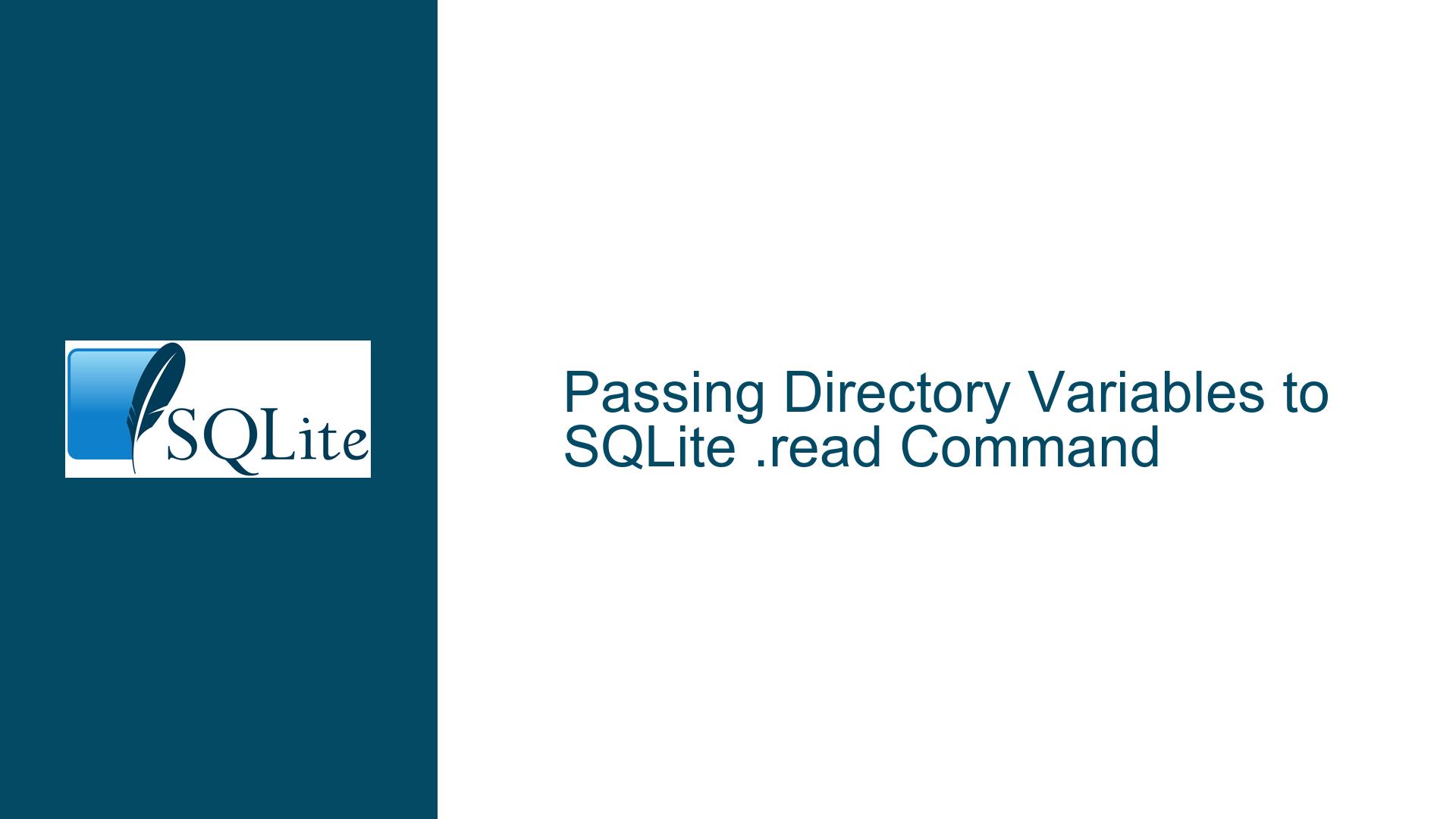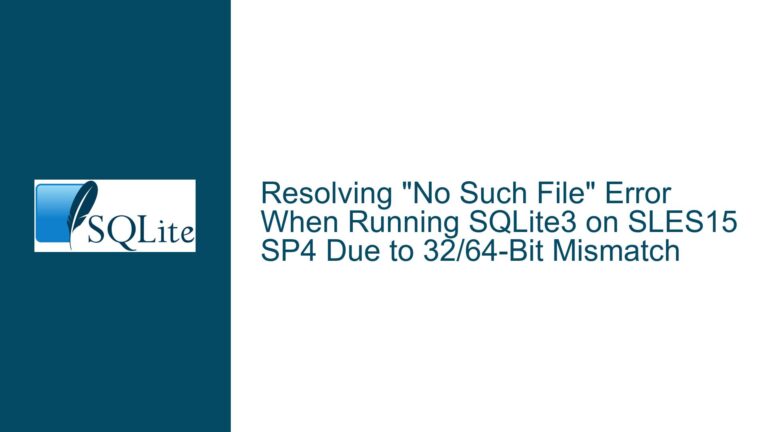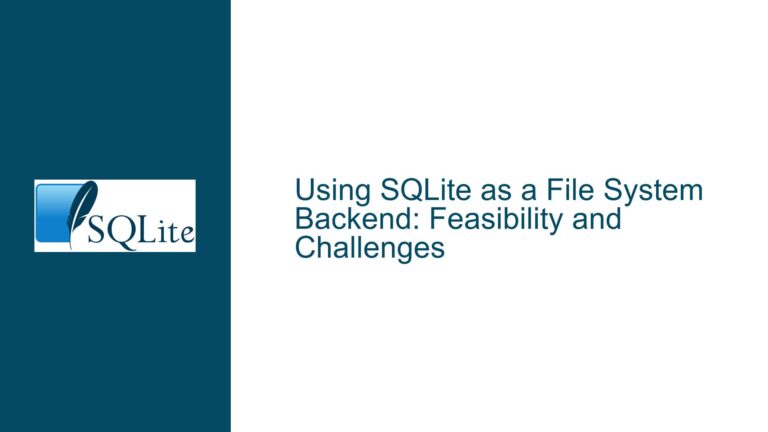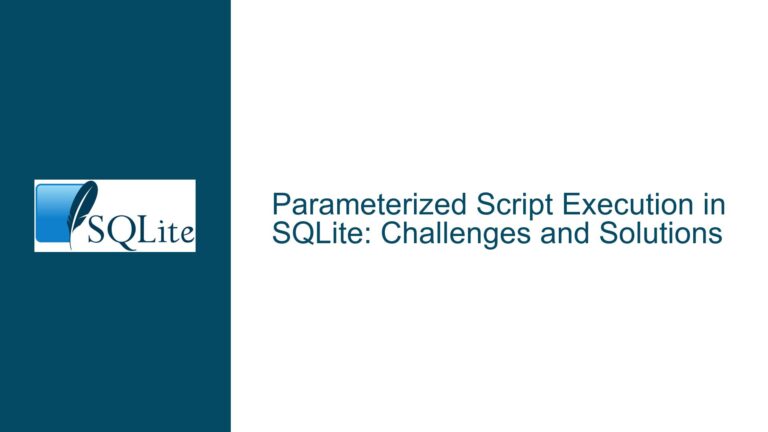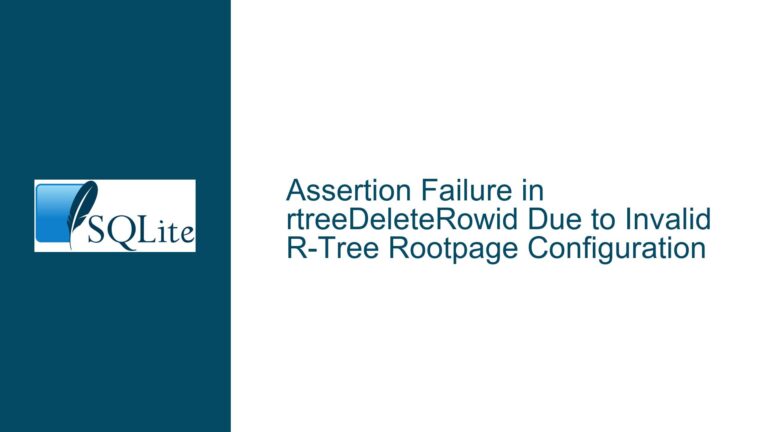Passing Directory Variables to SQLite .read Command
Issue Overview: Variable Substitution in SQLite .read Command
The core issue revolves around the inability to directly pass a directory variable to the SQLite .read command within an SQL file. The user, Leam, is working with an SQLite database setup where they use .read commands to execute SQL scripts for schema creation and data population. The scripts are located in a specific directory, and the user wants to make the directory path dynamic, allowing the same SQL file to be used in different environments (e.g., production and test) without manually editing the directory paths.
The primary challenge is that SQLite does not natively support variable substitution within SQL files. This limitation forces users to either hard-code directory paths or rely on external tools or shell scripts to manage these variables. The user’s goal is to maintain a single SQL file that can adapt to different directory structures without requiring manual intervention.
The discussion highlights two main approaches to address this issue: using shell environment variables and leveraging subprocesses within the SQLite CLI. However, the user explicitly clarifies that they are looking for a solution that works within an SQL file, not a shell script. This constraint narrows down the potential solutions and raises questions about the feasibility of achieving dynamic directory paths purely within SQLite.
Possible Causes: Why SQLite Lacks Native Variable Substitution in .read
The inability to use variable substitution directly within SQLite’s .read command stems from several design and implementation factors inherent to SQLite’s architecture. Understanding these causes is crucial for identifying workarounds and evaluating their suitability.
First, SQLite is designed to be a lightweight, embedded database engine. Its primary focus is on simplicity, portability, and minimal resource usage. As a result, SQLite does not include advanced scripting or templating features that are common in more complex database systems like PostgreSQL or MySQL. The .read command is a straightforward utility for executing SQL commands from a file, and it does not support advanced features like variable substitution or conditional logic.
Second, SQLite’s CLI (Command Line Interface) is intentionally kept simple to avoid bloat. The CLI is primarily a tool for interactive use and basic scripting, and it does not include a full-fledged scripting language. While SQLite does support some meta-commands (e.g., .tables, .schema), these are limited in scope and functionality. The lack of a built-in mechanism for variable substitution is consistent with SQLite’s philosophy of keeping the CLI lightweight and easy to use.
Third, SQLite’s CLI does not have a concept of runtime variables or parameterized inputs. Unlike some other database systems that allow users to define and use variables within SQL scripts, SQLite treats SQL files as static input. This design choice simplifies the implementation of the CLI but limits its flexibility in scenarios where dynamic input is required.
Finally, SQLite’s CLI is not designed to interact directly with the operating system or shell environment. While it can execute shell commands using the .shell meta-command, this functionality is limited and does not provide a seamless way to integrate shell variables or environment variables into SQL scripts. This separation between SQLite and the shell environment is intentional, as it ensures that SQLite remains platform-independent and does not rely on specific shell features or operating system capabilities.
Troubleshooting Steps, Solutions & Fixes: Achieving Dynamic Directory Paths in SQLite
Given the constraints of SQLite’s CLI and the user’s requirement to avoid shell scripts, there are several approaches to achieve dynamic directory paths within SQL files. These solutions range from creative use of SQLite’s existing features to leveraging external tools in a way that minimizes manual intervention.
1. Using SQLite’s .shell Command to Inject Variables
While SQLite does not support variable substitution directly within SQL files, it does provide the .shell meta-command, which allows users to execute shell commands from within the SQLite CLI. This feature can be used to inject directory paths dynamically into SQL scripts.
For example, consider the following SQL file (write_people_db.sql):
-- Set the directory path using a shell command
.shell echo "data/" > /tmp/sqlite_dir.txt
-- Read the directory path from the temporary file
.read /tmp/sqlite_dir.txt
-- Use the directory path in subsequent .read commands
.read data/write_cultures_table.sql
.read data/add_cultures_data.sql
In this example, the .shell command is used to write the directory path to a temporary file (/tmp/sqlite_dir.txt). The .read command then reads the directory path from the temporary file and uses it in subsequent .read commands. This approach allows the directory path to be dynamically set without hard-coding it in the SQL file.
However, this solution has some limitations. It relies on the availability of a temporary file system and requires additional steps to manage the temporary file. It also introduces a dependency on the shell environment, which may not be ideal for all use cases.
2. Leveraging SQLite’s .import Command for Data Population
If the primary use case for dynamic directory paths is data population, SQLite’s .import command can be used as an alternative to .read. The .import command reads data from a CSV file and inserts it into a table, and it supports file paths that can be dynamically set using shell commands.
For example, consider the following SQL file (write_people_db.sql):
-- Set the directory path using a shell command
.shell echo "data/" > /tmp/sqlite_dir.txt
-- Read the directory path from the temporary file
.read /tmp/sqlite_dir.txt
-- Use the directory path in subsequent .import commands
.import data/cultures.csv cultures
.import data/people.csv people
In this example, the .import command is used to populate the cultures and people tables from CSV files located in the data/ directory. The directory path is dynamically set using the same approach as in the previous example.
This solution is particularly useful for data population tasks, as it eliminates the need for separate SQL scripts for data insertion. However, it does not address the issue of dynamic directory paths for schema creation or other SQL commands.
3. Using SQLite’s .once Command to Generate Dynamic SQL Scripts
Another approach is to use SQLite’s .once command to generate dynamic SQL scripts that include the desired directory paths. The .once command writes the output of a query to a file, which can then be executed using the .read command.
For example, consider the following SQL file (write_people_db.sql):
-- Set the directory path using a shell command
.shell echo "data/" > /tmp/sqlite_dir.txt
-- Read the directory path from the temporary file
.read /tmp/sqlite_dir.txt
-- Generate a dynamic SQL script with the directory path
.once /tmp/dynamic_script.sql
SELECT '.read ' || 'data/write_cultures_table.sql';
SELECT '.read ' || 'data/add_cultures_data.sql';
-- Execute the dynamic SQL script
.read /tmp/dynamic_script.sql
In this example, the .once command is used to generate a dynamic SQL script (/tmp/dynamic_script.sql) that includes the directory path. The .read command then executes the dynamic script, allowing the directory path to be dynamically set.
This solution provides a high degree of flexibility, as it allows for the generation of complex SQL scripts with dynamic content. However, it also introduces additional complexity and requires careful management of temporary files.
4. Using SQLite’s .system Command to Execute Shell Commands
For users who are comfortable with shell scripting, SQLite’s .system command can be used to execute shell commands directly from within the SQLite CLI. This command provides a way to integrate shell variables and environment variables into SQL scripts.
For example, consider the following SQL file (write_people_db.sql):
-- Set the directory path using a shell command
.system export SQLDIR="data/"
-- Use the directory path in subsequent .read commands
.read $SQLDIR/write_cultures_table.sql
.read $SQLDIR/add_cultures_data.sql
In this example, the .system command is used to set the SQLDIR environment variable, which is then used in subsequent .read commands. This approach allows the directory path to be dynamically set using shell variables.
However, this solution has some limitations. It relies on the availability of a shell environment and may not be portable across different operating systems or shell environments. It also introduces a dependency on shell scripting, which may not be ideal for all use cases.
5. Using SQLite’s .parameter Command for Parameterized Queries
While SQLite’s .parameter command is primarily used for parameterized queries, it can also be used to manage dynamic values within SQL scripts. This command allows users to define and use named parameters in SQL queries, which can be set dynamically using shell commands or other methods.
For example, consider the following SQL file (write_people_db.sql):
-- Set the directory path using a shell command
.shell echo "data/" > /tmp/sqlite_dir.txt
-- Read the directory path from the temporary file
.read /tmp/sqlite_dir.txt
-- Define a named parameter for the directory path
.parameter set @SQLDIR data/
-- Use the named parameter in subsequent .read commands
.read @SQLDIR/write_cultures_table.sql
.read @SQLDIR/add_cultures_data.sql
In this example, the .parameter command is used to define a named parameter (@SQLDIR) for the directory path. The named parameter is then used in subsequent .read commands, allowing the directory path to be dynamically set.
This solution provides a high degree of flexibility and can be used in conjunction with other SQLite features to create complex, dynamic SQL scripts. However, it also introduces additional complexity and requires careful management of named parameters.
6. Using SQLite’s .import Command with Named Parameters
For users who need to populate data from CSV files, SQLite’s .import command can be used in conjunction with named parameters to achieve dynamic directory paths. This approach allows users to define the directory path as a named parameter and use it in subsequent .import commands.
For example, consider the following SQL file (write_people_db.sql):
-- Set the directory path using a shell command
.shell echo "data/" > /tmp/sqlite_dir.txt
-- Read the directory path from the temporary file
.read /tmp/sqlite_dir.txt
-- Define a named parameter for the directory path
.parameter set @SQLDIR data/
-- Use the named parameter in subsequent .import commands
.import @SQLDIR/cultures.csv cultures
.import @SQLDIR/people.csv people
In this example, the .parameter command is used to define a named parameter (@SQLDIR) for the directory path. The named parameter is then used in subsequent .import commands, allowing the directory path to be dynamically set.
This solution is particularly useful for data population tasks, as it eliminates the need for separate SQL scripts for data insertion. However, it does not address the issue of dynamic directory paths for schema creation or other SQL commands.
7. Using SQLite’s .read Command with Subprocesses
As suggested by Larry Brasfield in the discussion, SQLite’s .read command can be used with subprocesses to achieve dynamic directory paths. This approach involves using a subprocess to generate the SQL commands dynamically and then passing the output to the .read command.
For example, consider the following SQL file (write_people_db.sql):
-- Use a subprocess to generate the SQL commands dynamically
.read | echo ".read data/write_cultures_table.sql"
.read | echo ".read data/add_cultures_data.sql"
In this example, the .read command is used with a subprocess (echo) to generate the SQL commands dynamically. The subprocess outputs the desired .read commands, which are then executed by the SQLite CLI.
This solution provides a high degree of flexibility, as it allows for the generation of complex SQL commands with dynamic content. However, it also introduces additional complexity and requires careful management of subprocesses.
8. Using SQLite’s .shell Command with Named Parameters
For users who need to execute shell commands dynamically, SQLite’s .shell command can be used in conjunction with named parameters to achieve dynamic directory paths. This approach allows users to define the directory path as a named parameter and use it in subsequent .shell commands.
For example, consider the following SQL file (write_people_db.sql):
-- Set the directory path using a shell command
.shell echo "data/" > /tmp/sqlite_dir.txt
-- Read the directory path from the temporary file
.read /tmp/sqlite_dir.txt
-- Define a named parameter for the directory path
.parameter set @SQLDIR data/
-- Use the named parameter in subsequent .shell commands
.shell echo "Working in directory @SQLDIR"
.shell sqlite3 @SQLDIR/test_people.db < @SQLDIR/write_people_db.sql
In this example, the .parameter command is used to define a named parameter (@SQLDIR) for the directory path. The named parameter is then used in subsequent .shell commands, allowing the directory path to be dynamically set.
This solution provides a high degree of flexibility and can be used in conjunction with other SQLite features to create complex, dynamic SQL scripts. However, it also introduces additional complexity and requires careful management of named parameters.
9. Using SQLite’s .import Command with Subprocesses
For users who need to populate data from CSV files dynamically, SQLite’s .import command can be used with subprocesses to achieve dynamic directory paths. This approach involves using a subprocess to generate the .import commands dynamically and then passing the output to the SQLite CLI.
For example, consider the following SQL file (write_people_db.sql):
-- Use a subprocess to generate the .import commands dynamically
.import | echo "data/cultures.csv cultures"
.import | echo "data/people.csv people"
In this example, the .import command is used with a subprocess (echo) to generate the .import commands dynamically. The subprocess outputs the desired .import commands, which are then executed by the SQLite CLI.
This solution provides a high degree of flexibility, as it allows for the generation of complex .import commands with dynamic content. However, it also introduces additional complexity and requires careful management of subprocesses.
10. Using SQLite’s .once Command with Named Parameters
For users who need to generate dynamic SQL scripts with named parameters, SQLite’s .once command can be used in conjunction with named parameters to achieve dynamic directory paths. This approach allows users to define the directory path as a named parameter and use it in subsequent .once commands.
For example, consider the following SQL file (write_people_db.sql):
-- Set the directory path using a shell command
.shell echo "data/" > /tmp/sqlite_dir.txt
-- Read the directory path from the temporary file
.read /tmp/sqlite_dir.txt
-- Define a named parameter for the directory path
.parameter set @SQLDIR data/
-- Use the named parameter in subsequent .once commands
.once /tmp/dynamic_script.sql
SELECT '.read ' || @SQLDIR || '/write_cultures_table.sql';
SELECT '.read ' || @SQLDIR || '/add_cultures_data.sql';
-- Execute the dynamic SQL script
.read /tmp/dynamic_script.sql
In this example, the .parameter command is used to define a named parameter (@SQLDIR) for the directory path. The named parameter is then used in subsequent .once commands to generate a dynamic SQL script (/tmp/dynamic_script.sql) that includes the directory path. The .read command then executes the dynamic script, allowing the directory path to be dynamically set.
This solution provides a high degree of flexibility and can be used in conjunction with other SQLite features to create complex, dynamic SQL scripts. However, it also introduces additional complexity and requires careful management of named parameters and temporary files.
Conclusion
While SQLite does not natively support variable substitution within SQL files, there are several creative workarounds that can be used to achieve dynamic directory paths. These solutions range from using shell commands and temporary files to leveraging SQLite’s .import, .once, and .parameter commands. Each approach has its own advantages and limitations, and the best solution will depend on the specific requirements and constraints of the use case.
By understanding the underlying causes of SQLite’s limitations and exploring the various workarounds, users can effectively manage dynamic directory paths and maintain flexible, reusable SQL scripts. Whether through shell scripting, subprocesses, or named parameters, there are multiple ways to achieve the desired functionality while staying within the constraints of SQLite’s design.
